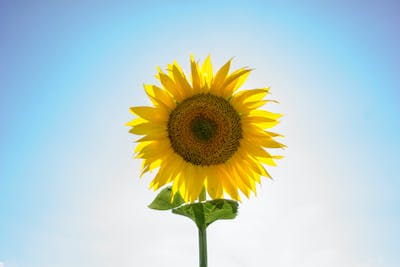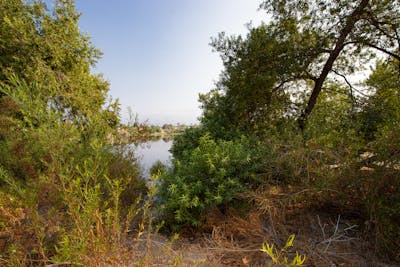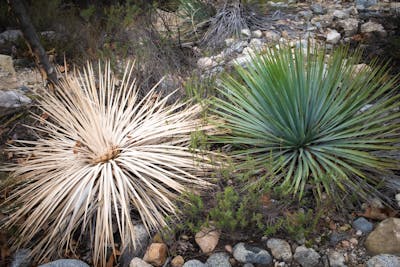Calfornia sagebrush is one of the most iconic plants of California chaparral communities, it is extremely drought tolerant, and has great medicinal and habitat value. It is a must-have in almost any native California landscape project.
Imagine a valley in California, away from the desert and not too close to the ocean. What would it have looked like if people had never been there? You can find traces of what might have been in mountainous canyons, preserved along hiking trails, but even these places are tainted by invasive plants and animal species, or by extinctions and other ecological disruptions.
Maybe these traces are enough to imagine what should be there. The occasional large oak tree, surrounded by bushy scrub oaks, manzanita, toyon, chamise, and round, fluffy balls of sagebrush.
Misconceptions About Sagebrush
Growing up there were a few things I was taught about California’s native sagebrush that were just wrong. First of all, do not confuse it with Russian thistle (Kali tragus), which is an invasive plant that makes up most of our tumbleweed.
Sagebrush is also not responsible for California’s brushfire problems. Our brushfire’s have been intensifying in recent decades due to causes like human encroachment on forests, global warming, intense drought and invasive species such as the Russian thistle and black mustard.
The brush that builds up and fuels these fires is made up of an unnaturally large amount of annuals, the Russian thistle, black mustard and others that complete their lifecycles by summer, dying off completely in summer, leaving behind dry, dead brush that burns very easily and very hot.
Sagebrush, on the other hand, is a perennial and is adapted to brushfires. It is a perennial, and instead of dying in the summer, it goes dormant. To the untrained eye they may appear sickly or dead, much like a deciduous tree may look dead in the winter. When the sagebrush burns, it burns at a lower temperature, making a fire that doesn’t spread so easily in the out-of-control-for-weeks scenarios we’ve been seeing in recent decades. In the types of fires these sagebrushes are adapted for, the aboveground portion of the plant is destroyed, but the underground root system and rhizomes remain alive, cool enough to survive the burning. When the threat has passed, they regrow from the rhizomes.
Finally, a misconception that may pop up from time to time is the idea that sagebrush is a “sage.” Sages are of the genus Salvia in the mint family, Lamiaceae. Sagebrush, on the other hand, is of the genus Artemisia, in the sunflower family, Asteraceae. The misleading name probably comes from the aromatics, California Sagebrush can easily compete with any Salvia for its rich aromatics.
Related Plants
There are many, many sagebrushes (Artemisia) found globally, about 400 species. There is Artemisia absinthium, the wormwood used for making absinthe. Another is the french culinary herb, Artemisia dracunculus, aka tarragon. Various species of sagebrush are found in other dry states in North America, like Artemisia tripartita, which is a characteristic plant of much of the Great Basin. California has about 20 species of sagebrush, including coastal sagebrush, mugwort, and wild tarragon, which is the same species as French tarragon.
Ecology and Herbalism
California sagebrush is found throughout California from coastal sage scrub, coastal strand, chaparral, and dry foothill communities, up to 3,300 feet in elevation.
California Sagebrush has a lot of medicinal value to indiginous people. So it is a little surprising to learn that it has little food value for wildlife. This is because it is rich in terpenes, which are bitter and unpalatable. It is, however, an important habitat plant for small birds and other animals. It is loved by quail and it is especially important to the endangered California gnatcatcher.
As a medicinal plant, the leaves of Artemisia californica can be chewed to ease menstrual cramps and labor. Leaves can be applied directly to wounds, or a liniment can be made and applied to a wound, or in the area of a broken bone, as a powerful, non-opiate pain reliever. It can even be used to remove skunk odor.
In the Garden
California sagebrush is a great plant to include in a California native garden. For one, it helps establish the character of a natural California setting. And, as mentioned above, it is an important habitat plant for some birds. It also requires almost no water. If yours is a dry garden, this is a great plant to incorporate while also providing a break from the usual xeriscaping of succulents and cacti.
It is also fast growing and will be able to establish itself in a season. It grows to a height of 3-6 feet. Although it will easily spread, it is not too difficult to keep in check with periodic maintenance. To maintain a fresh, well-kempt look in your home garden, prune out the leafless woody parts in the fall.
California Sagebrush tolerates different soils, but prefers dry slopes, usually south facing. They can take a lot of direct heat and do not like to soak in water. They tend to be more coastal, their communities are Chaparral, Coastal Sage Scrub, Coastal Strand and Central Oak Woodland and they do well amongst Black Sage, White Sage, California Encelia, Chamise, Coyote Brush, California Buckwheat, Sticky Monkeyflower, Woolly Bluecurls, Scrub Oaks, Toyon and Lemonadeberry.




